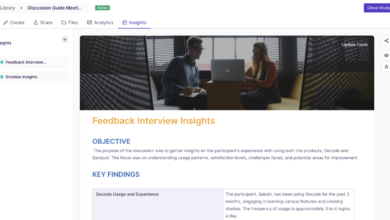
Harnessing the Power of Implicit Intent
Harnessing the power of implicit intent is like learning to read minds – not literally, of course, but close enough! We’re talking about understanding what users want before they even explicitly say it. This involves delving into the subtle clues hidden within their online behavior: their browsing history, purchase patterns, even the way they navigate a website. It’s a fascinating blend of technology and psychology, unlocking a powerful way to create truly personalized and intuitive experiences.
This exploration will cover everything from defining implicit intent and contrasting it with explicit intent to discussing the ethical considerations of using this powerful technology. We’ll examine how machine learning algorithms can predict user needs and the various applications of this understanding, from personalized recommendations to enhancing search engine efficiency. We’ll also look at the potential pitfalls and challenges, such as algorithmic bias and privacy concerns, ensuring we navigate this exciting field responsibly.
Defining Implicit Intent
Understanding user intent is crucial for building effective and engaging digital experiences. While explicit intent is straightforward – the user directly communicates their needs – implicit intent is a more subtle, yet powerful, force shaping user behavior. It’s about deciphering the unspoken desires and underlying motivations behind a user’s actions. Mastering the art of recognizing and responding to implicit intent is key to creating truly personalized and intuitive systems.Implicit intent refers to the user’s unexpressed or indirectly communicated needs and goals.
Unlike explicit intent, which is clearly stated (e.g., “Find red shoes size 8”), implicit intent is inferred from user behavior, context, and other indirect signals. This requires a deeper understanding of user psychology and the ability to interpret subtle cues. Think of it as reading between the lines of user interaction. The difference between explicit and implicit intent lies in the level of directness and the need for interpretation.
Examples of Implicit Intent Across Domains
Implicit intent manifests in various ways across different digital platforms. In search engines, for example, a user searching for “best Italian restaurants near me” explicitly states their need for restaurant recommendations. However, their choice of search terms, location settings, and past search history can reveal implicit intent – perhaps they are looking for a romantic dinner, a family-friendly atmosphere, or a place with outdoor seating.
These unspoken preferences can be used to refine search results and provide a more personalized experience.In e-commerce, implicit intent is revealed through browsing behavior. A user spending considerable time viewing hiking boots, reading product reviews, and adding similar items to their wish list implicitly signals their intention to purchase hiking gear. Websites can leverage this information to personalize recommendations, offer targeted promotions, and improve the overall shopping experience.
Customer service interactions also offer insights into implicit intent. A user repeatedly contacting support about a specific product feature may implicitly indicate dissatisfaction or a need for improved documentation, even if they don’t explicitly state it.
Comparison of Understanding Explicit and Implicit User Needs
Understanding explicit user needs is relatively straightforward; the user directly communicates their requirements. This allows for immediate and direct responses. However, relying solely on explicit intent limits the ability to anticipate user needs and provide proactive solutions. Understanding implicit intent, on the other hand, requires sophisticated data analysis and machine learning techniques to interpret user behavior, context, and patterns.
This allows for more personalized and proactive experiences, anticipating user needs before they are explicitly stated. For instance, a music streaming service might identify a user’s preference for a specific genre based on their listening history, even if they haven’t explicitly stated their preference. This enables the service to proactively recommend similar artists and albums, enhancing user satisfaction. A comparison can be made using a table:
| Feature | Explicit Intent | Implicit Intent |
|---|---|---|
| Communication | Direct and clear | Indirect and inferred |
| Interpretation | Minimal interpretation required | Requires sophisticated data analysis |
| Response | Direct and immediate | Proactive and personalized |
| Example | “I want to buy a new laptop.” | Repeated visits to laptop comparison websites, adding laptops to a shopping cart but not completing the purchase. |
Identifying Implicit Intent in User Behavior: Harnessing The Power Of Implicit Intent
Uncovering implicit intent, the unspoken desires and needs driving user actions, is crucial for creating truly personalized and effective digital experiences. It’s about moving beyond explicit requests and understanding the underlying motivations behind a user’s behavior. This involves analyzing a wealth of data to identify patterns and predict future actions. This isn’t about guessing; it’s about leveraging data-driven insights to anticipate needs and deliver relevant solutions.By analyzing user data, we can begin to understand the “why” behind the “what.” This allows for a more proactive and personalized approach to user interaction, leading to improved engagement and satisfaction.
However, accurately interpreting implicit signals presents a unique set of challenges.
Methodology for Detecting Implicit Intent from User Data, Harnessing the power of implicit intent
A robust methodology for detecting implicit intent needs to integrate various data sources and analytical techniques. This involves collecting data from diverse touchpoints, including browsing history, purchase patterns, search queries, social media activity, and even mouse movements and scrolling behavior on a website. This multifaceted approach allows for a more holistic understanding of user behavior. Once data is collected, machine learning algorithms, particularly those capable of handling sequential data like recurrent neural networks (RNNs) or transformers, can be employed to identify patterns and predict future actions.
These algorithms learn from the historical data to build models that can anticipate user intent. For example, an RNN could analyze a user’s browsing history to predict their likely next purchase based on the sequence of websites visited.
Challenges in Accurately Interpreting Implicit Signals
Accurately interpreting implicit signals is challenging due to several factors. First, the data itself can be noisy and incomplete. Users may not always leave a clear digital trail, or their behavior may be influenced by external factors that are difficult to account for. Second, implicit signals are often ambiguous and open to multiple interpretations. A user adding a product to their shopping cart might indicate intent to purchase, but it could also be for price comparison or simply saving it for later.
Third, the interpretation of implicit intent is highly context-dependent. The same action can have different meanings depending on the user’s demographics, past behavior, and the current situation. Finally, ethical considerations arise around privacy and potential biases embedded in the algorithms used for interpretation.
Hypothetical Scenario Demonstrating Misinterpretation of Implicit Intent
Imagine an e-commerce website analyzing user data to personalize recommendations. A user repeatedly browses hiking boots but never purchases them. The algorithm, solely focused on browsing history, might conclude a strong intent to buy hiking boots and aggressively push related products, including expensive accessories. However, the user’s actual intent might be simply researching options for an upcoming trip, without a definite purchase plan.
The aggressive marketing based on a misinterpreted implicit intent could be counterproductive, leading to frustration and a negative user experience. The algorithm failed to account for the lack of purchase action, leading to a flawed interpretation of the browsing behavior.
Technological Approaches to Harnessing Implicit Intent
Understanding and leveraging implicit intent requires sophisticated technological solutions. The ability to accurately predict what a user wants before they explicitly state it is a key challenge, and one that is increasingly being addressed through the power of machine learning. By analyzing vast amounts of user data, these algorithms can identify patterns and predict future behavior with remarkable accuracy.
Machine Learning Algorithms for Implicit Intent Prediction
Machine learning plays a crucial role in predicting implicit intent by identifying patterns and correlations within user data that might not be immediately obvious to a human observer. These algorithms learn from historical data, allowing them to improve their predictive accuracy over time. The more data they are trained on, the better they become at understanding subtle nuances in user behavior.
This allows for personalized experiences and proactive service delivery, enhancing user satisfaction and engagement.
Machine Learning Models for Implicit Intent
Several machine learning models are particularly well-suited for predicting implicit intent. These models differ in their approach and the type of data they best utilize. Choosing the right model depends on the specific application and the nature of the available data.
| Model Type | Description | Strengths | Weaknesses |
|---|---|---|---|
| Recommendation Systems (e.g., Collaborative Filtering, Content-Based Filtering) | These systems predict user preferences based on past behavior and the behavior of similar users. | Highly effective at personalizing recommendations; can handle large datasets; relatively simple to implement. | Can suffer from the cold-start problem (difficulty recommending items to new users or recommending new items); may not capture complex relationships between items and users; susceptible to biases in the training data. |
| Natural Language Processing (NLP) Models (e.g., Recurrent Neural Networks, Transformers) | NLP models analyze textual data, such as user reviews, search queries, and social media posts, to understand user needs and intentions. | Can capture nuanced language and context; capable of understanding complex relationships between words and phrases; can be used to predict intent from unstructured text data. | Requires large amounts of training data; can be computationally expensive; may struggle with ambiguity and sarcasm in language. |
| Markov Models | These probabilistic models predict the next state based on the current state, making them useful for sequential data like user browsing history. | Simple to understand and implement; computationally efficient; can handle large datasets. | May not capture long-range dependencies; assumptions about state independence can be limiting. |
| Reinforcement Learning | These models learn optimal strategies through trial and error, making them suitable for dynamic environments where user behavior changes over time. | Can adapt to changing user behavior; can optimize for specific goals, such as maximizing user engagement. | Requires careful design of reward functions; can be computationally expensive; may require significant experimentation to find optimal parameters. |
Applications of Implicit Intent Understanding
Understanding implicit intent isn’t just a technological marvel; it’s a powerful tool for enhancing user experience and driving business success. By moving beyond explicit requests and interpreting unspoken needs, businesses can create more intuitive and personalized interactions, leading to improved customer satisfaction and bottom-line results. This section explores how this understanding translates into tangible applications across various domains.
The ability to decipher implicit intent allows systems to anticipate user needs and proactively offer relevant solutions, resulting in a more seamless and enjoyable user journey. This proactive approach contrasts sharply with traditional systems that rely solely on explicit user commands, often leading to a fragmented and less efficient experience.
Personalized Recommendations through Implicit Intent
Personalized recommendations, a staple of e-commerce and streaming services, are significantly improved by incorporating implicit intent. Instead of relying solely on explicit ratings or reviews, systems can analyze browsing history, purchase patterns, and even dwell time on specific products to infer user preferences. For example, a user repeatedly browsing hiking boots and camping gear might implicitly express an intent to go hiking, prompting the system to recommend relevant items like backpacks, sleeping bags, and trail maps, even without an explicit search for these products.
This proactive approach increases the likelihood of relevant recommendations and enhances the user’s overall shopping experience. Netflix’s recommendation engine is a prime example, using viewing history and viewing time to suggest shows and movies a user might enjoy, even if they haven’t explicitly searched for them.
Impact of Implicit Intent on Business Outcomes: A Case Study
Amazon’s success is, in part, attributable to its masterful understanding and application of implicit intent. By analyzing user browsing behavior, purchase history, and interactions with the website, Amazon’s recommendation engine anticipates user needs and presents highly relevant products. This proactive approach leads to increased sales and improved customer loyalty. A study by McKinsey estimated that personalized recommendations increase sales by 10-15% for online retailers.
While specific numbers for Amazon’s increase are not publicly available, their continued success in the e-commerce arena speaks volumes about the effectiveness of this strategy. The impact extends beyond direct sales; increased customer satisfaction leads to repeat purchases and positive word-of-mouth marketing, further contributing to business growth.
Implicit Intent in Search Engines and Virtual Assistants
Search engines and virtual assistants are rapidly evolving to incorporate implicit intent understanding. Instead of simply returning results based on s, advanced search engines now analyze the context of a query, considering factors like location, past searches, and even the user’s current emotional state (inferred from language patterns) to provide more relevant and helpful results. Similarly, virtual assistants like Siri and Alexa are moving beyond simple command execution.
They can anticipate needs based on user routines and contextual information. For example, if a user frequently sets reminders for medication, the virtual assistant might proactively offer to set a reminder based on the user’s established schedule, even without a direct request. This proactive approach significantly enhances the efficiency and usability of these technologies, making them more intuitive and less reliant on explicit commands.
Ethical Considerations and Challenges

Harnessing the power of implicit intent, while offering incredible potential for personalized experiences and efficient systems, presents a complex ethical landscape. The very nature of inferring user desires without explicit expression raises significant concerns regarding bias, privacy, and transparency. Addressing these challenges is crucial to ensure responsible development and deployment of implicit intent technologies.The ability to predict user behavior based on implicit cues opens the door to various ethical dilemmas.
These concerns require careful consideration and proactive mitigation strategies to prevent unintended consequences and ensure fair and equitable outcomes.
Algorithmic Bias in Implicit Intent Interpretation
Algorithms designed to interpret implicit intent are trained on vast datasets of user behavior. If these datasets reflect existing societal biases, the algorithms will inevitably perpetuate and even amplify them. For instance, an algorithm trained on data showing a disproportionate number of men purchasing power tools might incorrectly infer that women are less interested in such products, leading to biased recommendations and potentially limiting opportunities for women.
This highlights the critical need for careful data curation and algorithmic auditing to identify and mitigate bias. Techniques like fairness-aware machine learning can help to create more equitable systems, but constant vigilance and ongoing evaluation are necessary.
Privacy Implications of Implicit Intent Data Collection
The collection and analysis of user data to infer implicit intent raises significant privacy concerns. Unlike explicit data, which users consciously provide, implicit intent data is often gathered without their full awareness or consent. This includes tracking browsing history, app usage patterns, location data, and even subtle physiological signals. The potential for misuse of this highly personal information is considerable, ranging from targeted advertising and manipulation to discriminatory practices.
Robust privacy-preserving techniques, such as federated learning and differential privacy, are essential to minimize the risk of unauthorized access and data breaches while still enabling the development of useful implicit intent systems. Strong data anonymization and encryption protocols are also crucial to protect user privacy.
Transparency and User Control in Implicit Intent Systems
Transparency and user control are paramount in building trust and ensuring ethical implementation of implicit intent technologies. Users should have a clear understanding of how their data is being collected, analyzed, and used to infer their implicit intent. They should also have the ability to access, correct, and delete their data, as well as control the level of personalization they receive.
Harnessing the power of implicit intent is key to building truly intuitive applications. Understanding user needs without explicit commands is a huge step forward, and platforms like Domino are leading the charge. Check out this article on domino app dev the low code and pro code future to see how this is being achieved, ultimately allowing developers to focus on crafting seamless user experiences built around implicit intent.
This is the future of app development!
This requires clear and accessible privacy policies, user-friendly data management tools, and mechanisms for users to opt out of implicit intent tracking. Furthermore, systems should be designed to provide explanations for their recommendations and predictions, allowing users to understand the reasoning behind the system’s inferences and challenge them if necessary. This level of transparency fosters accountability and empowers users to make informed decisions about their data and the systems that utilize it.
Future Directions and Innovations
The field of implicit intent understanding is poised for significant advancements, driven by both theoretical breakthroughs and rapid technological progress. Future research will focus on refining existing methods, exploring novel approaches, and addressing the ethical challenges inherent in predicting user behavior. This will lead to more accurate, reliable, and ethically sound applications across various domains.The path forward involves tackling several key areas to improve the accuracy and scope of implicit intent detection.
This includes refining existing machine learning models, developing new methods for handling noisy and ambiguous data, and addressing the inherent biases present in training data. Furthermore, interdisciplinary collaboration between computer scientists, psychologists, and ethicists will be crucial in ensuring responsible innovation.
Advanced Machine Learning Models for Implicit Intent Detection
Current methods rely heavily on deep learning architectures, primarily Recurrent Neural Networks (RNNs) and Transformers. Future research will explore more sophisticated models, such as graph neural networks (GNNs) which can better capture the complex relationships between different user interactions and contextual information. These models can potentially analyze user data across multiple modalities (text, images, sensor data) to build a more holistic understanding of implicit intent.
For instance, a GNN could model the relationship between a user’s search history, their online purchases, and their social media activity to predict their interest in a specific product category, even without explicit expressions of interest. This approach moves beyond simple sequential modeling to a more comprehensive understanding of user behavior patterns.
Improved Data Handling and Bias Mitigation
A major challenge in implicit intent understanding is the inherent noise and ambiguity present in user data. Future research will focus on developing robust methods for handling missing data, dealing with inconsistent user behavior, and mitigating the effects of bias in training data. This includes exploring techniques such as federated learning, which allows for training models on decentralized datasets without compromising user privacy, and developing algorithms that can explicitly identify and correct for biases in the data.
For example, addressing biases in recommendation systems that disproportionately favor certain demographics could be achieved by incorporating fairness-aware algorithms during the training process. This would lead to more equitable and inclusive applications.
Novel Application: Personalized Proactive Healthcare
A novel application leveraging implicit intent could be a proactive healthcare system that anticipates and addresses individual health needs before they manifest as acute problems. By analyzing data from wearable sensors, medical records, and online behavior, the system could detect subtle changes in patterns indicative of potential health issues. For example, a change in sleep patterns, coupled with increased online searches for symptoms of a specific illness, might trigger an alert for early intervention.
This system would not only provide personalized health recommendations but also offer support and resources to help individuals maintain their well-being. The system’s ability to understand implicit intent would be crucial in providing timely and relevant interventions, potentially preventing serious health complications. The framework would prioritize user privacy and data security, adhering to strict ethical guidelines and regulations.
Illustrative Examples of Implicit Intent
Understanding implicit intent requires careful observation of user behavior within their specific context. It’s about inferring what a user wants to achieve, rather than relying solely on explicit commands. The following examples illustrate how seemingly simple actions can reveal complex underlying intentions.
Example 1: Smart Home Automation and Ambient Temperature
Imagine Sarah, a busy professional, returning home after a long day. Her context is that she’s tired and wants to relax. Her environment is her smart home, equipped with a smart thermostat and lighting system. Instead of explicitly telling her smart home to adjust the temperature and lights, Sarah simply unlocks her front door using her smartphone.
This single action triggers a pre-programmed “welcome home” routine. The smart home system, understanding her implicit intent (to create a comfortable and relaxing environment), automatically lowers the thermostat to a pre-set temperature, dims the lights, and plays calming music. The visual representation would show a simple icon of a house unlocking, transitioning into a depiction of a comfortable living room with dimmed lights and a cozy temperature setting.
Example 2: E-commerce Product Recommendations
John is browsing an online bookstore website. His context is that he’s looking for a new book to read. His environment is his laptop at home. He spends a significant amount of time browsing the science fiction section, clicking on several books with similar themes and authors, and adding a few to his wish list. He doesn’t explicitly state “recommend similar books,” but the e-commerce platform infers his implicit intent based on his browsing behavior.
The system then suggests other science fiction books matching his preferences, authors he frequently clicks on, and books purchased by users with similar browsing patterns. The visual representation would show a flowchart, starting with John browsing books, then branching into multiple book covers, converging to a final suggestion box of recommended titles.
Example 3: Fitness App Workout Suggestions
Maria uses a fitness app to track her workouts. Her context is that she’s aiming to improve her cardiovascular health. Her environment is her home gym. Over the past week, she consistently tracks runs and cycling sessions, consistently exceeding her target distance and duration. She doesn’t explicitly state her goal, but the app infers her implicit intent to increase her fitness level and challenge herself further.
The app, observing her increased performance, suggests more challenging workouts, longer distances, or higher intensity intervals for her next sessions. The visual representation would be a graph showing her workout progress, with an upward trend, and then an arrow pointing towards a more challenging workout plan.
Concluding Remarks

Ultimately, harnessing the power of implicit intent isn’t just about improving user experience; it’s about building a deeper connection with our audience. By understanding the unspoken desires and needs of our users, we can create more intuitive, personalized, and ultimately, more successful products and services. The journey into understanding implicit intent is a continuous evolution, requiring ongoing refinement and ethical consideration.
But the potential rewards – enhanced user satisfaction, improved business outcomes, and the creation of truly intuitive technology – are well worth the effort.
Expert Answers
What are some common misinterpretations of implicit intent?
Common misinterpretations stem from assuming correlation equals causation. For example, a user viewing many running shoes might not mean they intend to buy them; they could be researching for a friend. Context is crucial, and neglecting it leads to inaccurate predictions.
How can businesses ethically use implicit intent data?
Ethical use prioritizes transparency and user control. Clearly communicate data collection practices, offer opt-out options, and ensure data is used responsibly, avoiding discriminatory outcomes. Regular audits and adherence to privacy regulations are essential.
What’s the difference between implicit and explicit feedback?
Explicit feedback is direct, like a survey response or product review. Implicit feedback is indirect, derived from user actions such as browsing history or time spent on a page. Combining both provides a richer understanding of user preferences.




